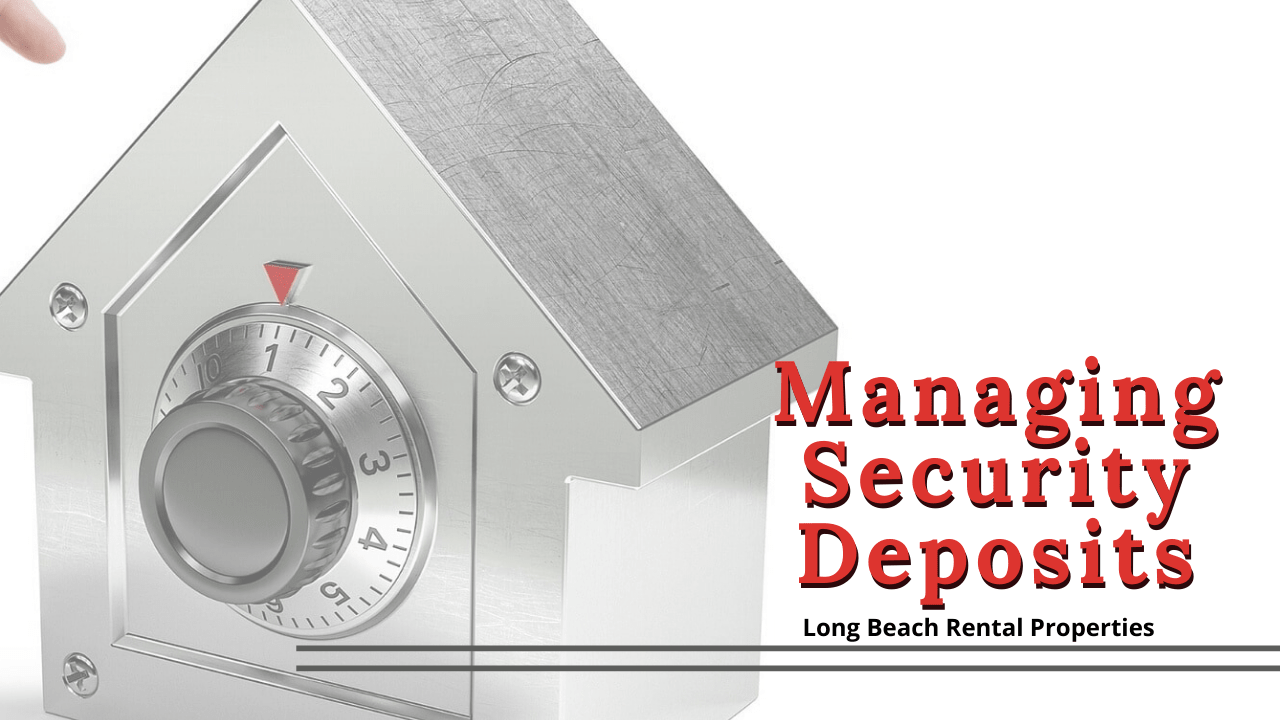
The security deposit is one of the most complex and confusing things for Long Beach landlords to deal with. Most people who rent out properties understand that a
security deposit needs to be collected; but, they often don’t understand the legal requirements that come with it.
Collecting and holding a security deposit is an essential part of the leasing and move-in process. Returning the security deposit is a major part of the
move-out process. If you’re working with a
professional Long Beach property management company, you won’t have much to worry about. Your property managers will be completely familiar with California security deposit law, and they’ll know how to handle things.
If you’re managing your own rental property in Long Beach, make sure you understand what’s required when it comes to a tenant’s security deposit. This is usually the most contested and litigated part of the
leasing process.
We’re covering most of the basics today, and we’re always here at Progressive Property Management to serve as a resource for landlords who are unsure what’s expected of them.
Collecting a Security Deposit: Limits and Best Practices
California has legal limits on how much landlords can collect as a security deposit, and the amount you can charge depends on whether your property is furnished or unfurnished and whether you’re renting to an active duty member of the military.
For an unfurnished rental, you are generally permitted to charge up to the equivalent of two months of rent. So, if you’re renting out a home for $2,500 per month and it’s unfurnished, your security deposit limit is $5,000.
If you’re renting out a home that is fully furnished, you can charge a security deposit that’s up to the equivalent of three months of rent. So, on your furnished $2,500 per month rental, your security deposit amount can be $7,500.
This is for your general tenants. If you’re renting to an active duty member of the military, the security deposits are lower. This is a law that just went into effect on January 1, 2020, and it’s not getting quite as much attention as the
rent control laws and other regulations, so you may have missed it. Your active duty military security deposits are limited to the equivalent of one month’s rent for an unfurnished unit and two months of rent for a furnished unit.
Just because you
can collect that much doesn’t mean you should. These are legal limits, not required amounts. Remember that your rental property is competing for good tenants. Don’t chase away highly qualified residents because your security deposit amount is too high. Many landlords charge around one month’s rent for a security deposit. Before you decide on what you’ll charge, take a look at your competition. When you
screen tenants well and respond to maintenance requests promptly, your security deposit in the amount of one month’s rent is usually enough to cover any damages or deductions.
Once you’ve collected a security deposit, hold it in a separate account that is not your own. You don’t want your funds co-mingling with your tenant’s money. We also recommend you document in your lease how much was collected and where it’s being held. This isn’t legally required, but it helps you stay organized and transparent with your tenants.
Returning the Security Deposit
There are a few important things you need to know about returning the tenant’s security deposit.
- Tenants are entitled to a walk-through inspection before they move out. We don’t usually have a lot of tenants request this, but if they do, you are legally required to provide it. You’ll schedule a time with your tenants a week or two before they move out to walk through the home and point out any issues or areas of concern that might result in a deduction from their security deposit. Then, they have the opportunity to make the repair themselves. If they don’t, there’s no reason for them to be surprised when you deduct from the deposit.
- You have 21 days to return the tenant’s security deposit. This is a firm and fixed deadline. Don’t wait until day 22 or 23. The clock starts ticking on the day the tenants hand over the keys and vacate the property. Be prepared, and return the deposit promptly. If you do make deductions, be sure to provide an itemized list of what was deducted and why. Include copies of receipts, invoices, and estimates.
- Be mindful of what you’re deducting. You cannot deduct for wear and tear items, but you can deduct for damage. Make sure you understand the difference because if you don’t, you will likely invite a tenant dispute and you may even find yourself in small claims court.
You’re required to send the deposit to the tenant’s forwarding address or their last known address if they did not provide a forwarding address.
What You Can and Cannot Deduct from the Deposit
There are generally five good reasons to make a deduction from your tenant’s security deposit:
- The tenant has overdue rent balances. If they didn’t pay the last month or they only paid half the rent the last two months of their tenancy, you can use the security deposit to cover the rent that has not been paid.
- Cleaning costs. In California, you can require the tenants to return your property in the same state of cleanliness that they received the home. So, make sure you documented the condition of the property before your tenants moved in. You can require a professional cleaning; sweeping the floor and wiping down the counters does not have to meet your requirements. If your tenants do not sufficiently clean the home before leaving it, you can pay to have it cleaned to the point that it’s ready to rent again, and then charge that cost back to your tenants.
- Damage to the home that can be documented as something beyond normal wear and tear. You cannot charge the deposit for small nail holes in the walls or scuff marks from where furniture rested. But, you can charge for large holes in the walls or scrapes across your wood floors.
- Additional expenses for which the tenant was responsible. An example would be unpaid water bills.
- Damage or expenses incurred by any lease violations. For example, if a pet scratched a door to the point that it’s damaged or the smell of that animal’s urine has required extra cleaning, you can charge the security deposit. Again, make sure these are well-documented.
You can’t charge for wear and tear and you can’t charge for things like re-keying the property. If a tenant fails to return all the keys or garage door openers, you can charge for that. But, outside of the five things listed above, you’re responsible as a landlord to cover any additional expenses.

Security deposits in California are always refundable. You cannot collect the deposit and tell the tenants that it’s non-refundable. This is illegal. Make sure you’re documenting the entire process of collecting, holding, and returning security deposits. You may need that documentation if you find yourself in court. Move-in and move-out inspection reports are also critical, especially if you have a tenant disputing a security deposit charge.
We’d be happy to help you avoid expensive security deposit mistakes.
Contact us at Progressive Property Management for more information.
 The security deposit is one of the most complex and confusing things for Long Beach landlords to deal with. Most people who rent out properties understand that a security deposit needs to be collected; but, they often don’t understand the legal requirements that come with it.
Collecting and holding a security deposit is an essential part of the leasing and move-in process. Returning the security deposit is a major part of the move-out process. If you’re working with a professional Long Beach property management company, you won’t have much to worry about. Your property managers will be completely familiar with California security deposit law, and they’ll know how to handle things.
If you’re managing your own rental property in Long Beach, make sure you understand what’s required when it comes to a tenant’s security deposit. This is usually the most contested and litigated part of the leasing process.
We’re covering most of the basics today, and we’re always here at Progressive Property Management to serve as a resource for landlords who are unsure what’s expected of them.
The security deposit is one of the most complex and confusing things for Long Beach landlords to deal with. Most people who rent out properties understand that a security deposit needs to be collected; but, they often don’t understand the legal requirements that come with it.
Collecting and holding a security deposit is an essential part of the leasing and move-in process. Returning the security deposit is a major part of the move-out process. If you’re working with a professional Long Beach property management company, you won’t have much to worry about. Your property managers will be completely familiar with California security deposit law, and they’ll know how to handle things.
If you’re managing your own rental property in Long Beach, make sure you understand what’s required when it comes to a tenant’s security deposit. This is usually the most contested and litigated part of the leasing process.
We’re covering most of the basics today, and we’re always here at Progressive Property Management to serve as a resource for landlords who are unsure what’s expected of them.
 Security deposits in California are always refundable. You cannot collect the deposit and tell the tenants that it’s non-refundable. This is illegal. Make sure you’re documenting the entire process of collecting, holding, and returning security deposits. You may need that documentation if you find yourself in court. Move-in and move-out inspection reports are also critical, especially if you have a tenant disputing a security deposit charge.
We’d be happy to help you avoid expensive security deposit mistakes. Contact us at Progressive Property Management for more information.
Security deposits in California are always refundable. You cannot collect the deposit and tell the tenants that it’s non-refundable. This is illegal. Make sure you’re documenting the entire process of collecting, holding, and returning security deposits. You may need that documentation if you find yourself in court. Move-in and move-out inspection reports are also critical, especially if you have a tenant disputing a security deposit charge.
We’d be happy to help you avoid expensive security deposit mistakes. Contact us at Progressive Property Management for more information.





